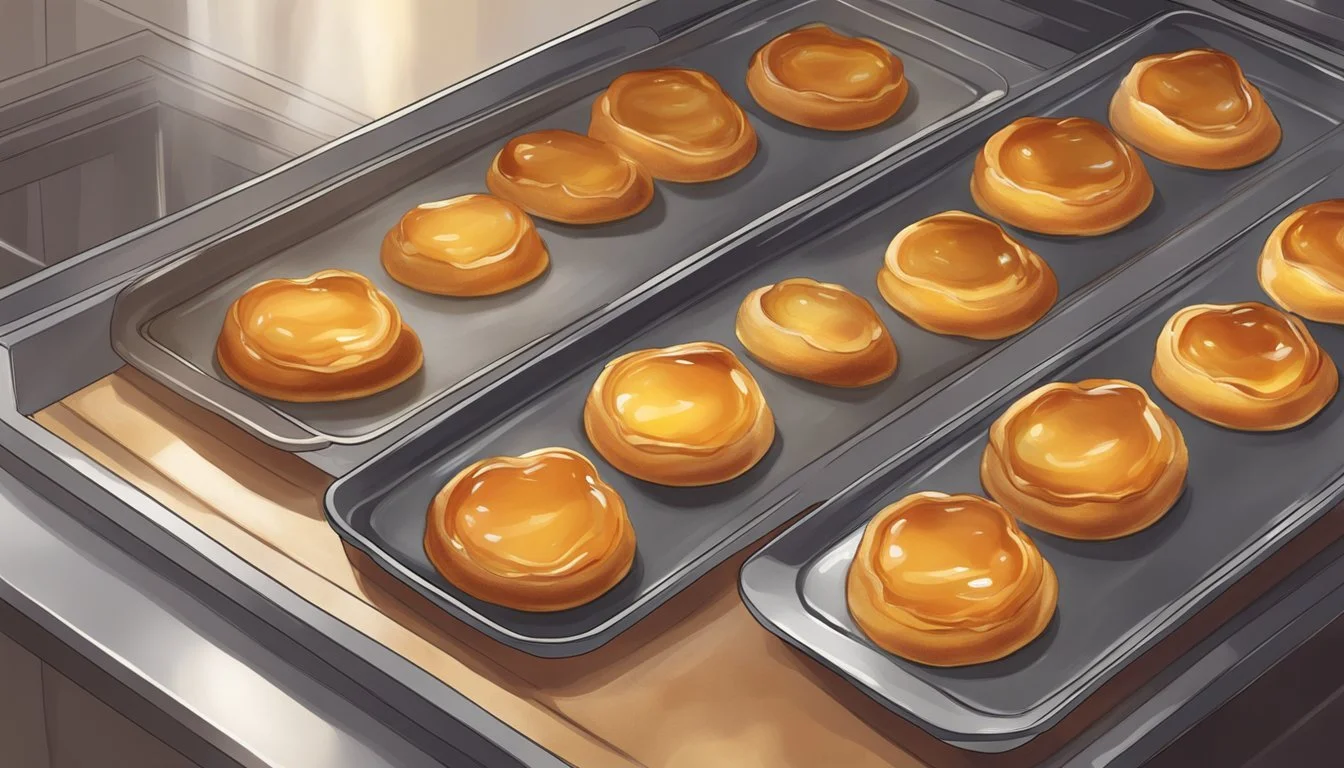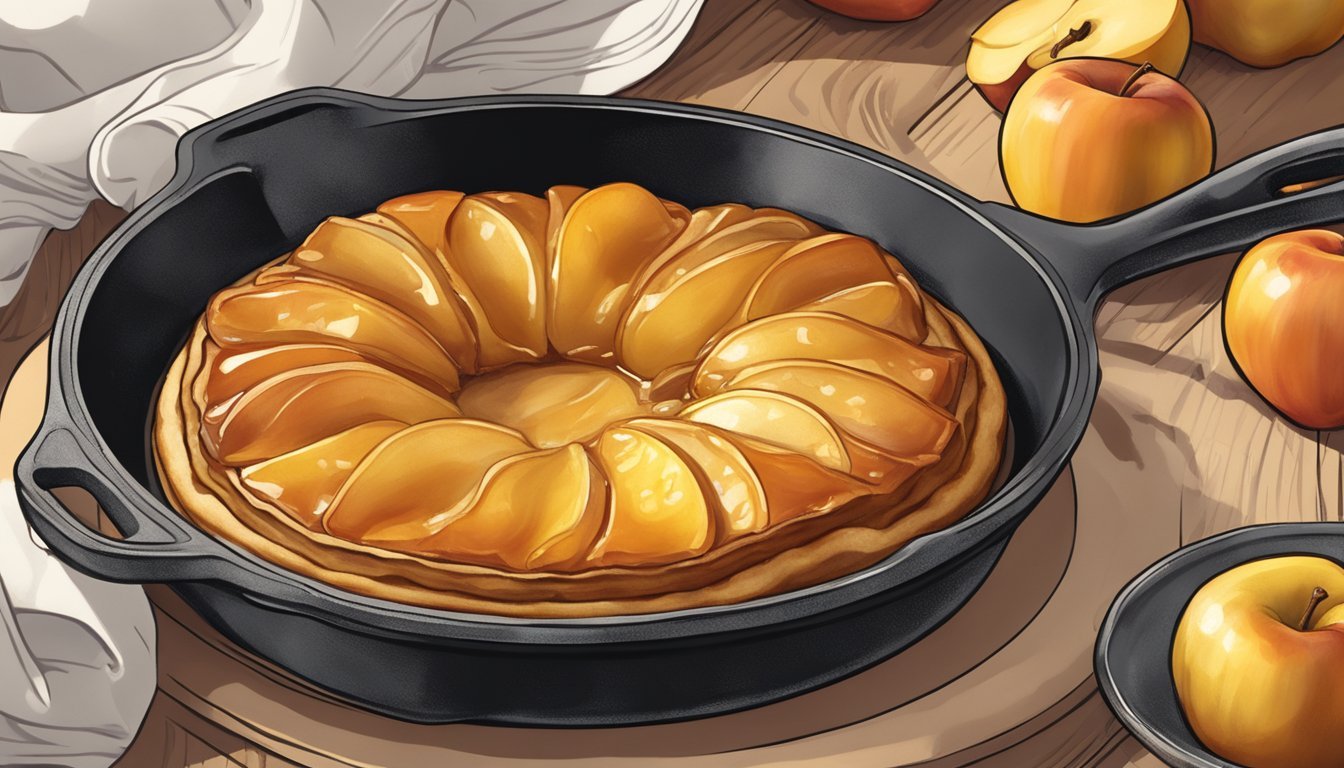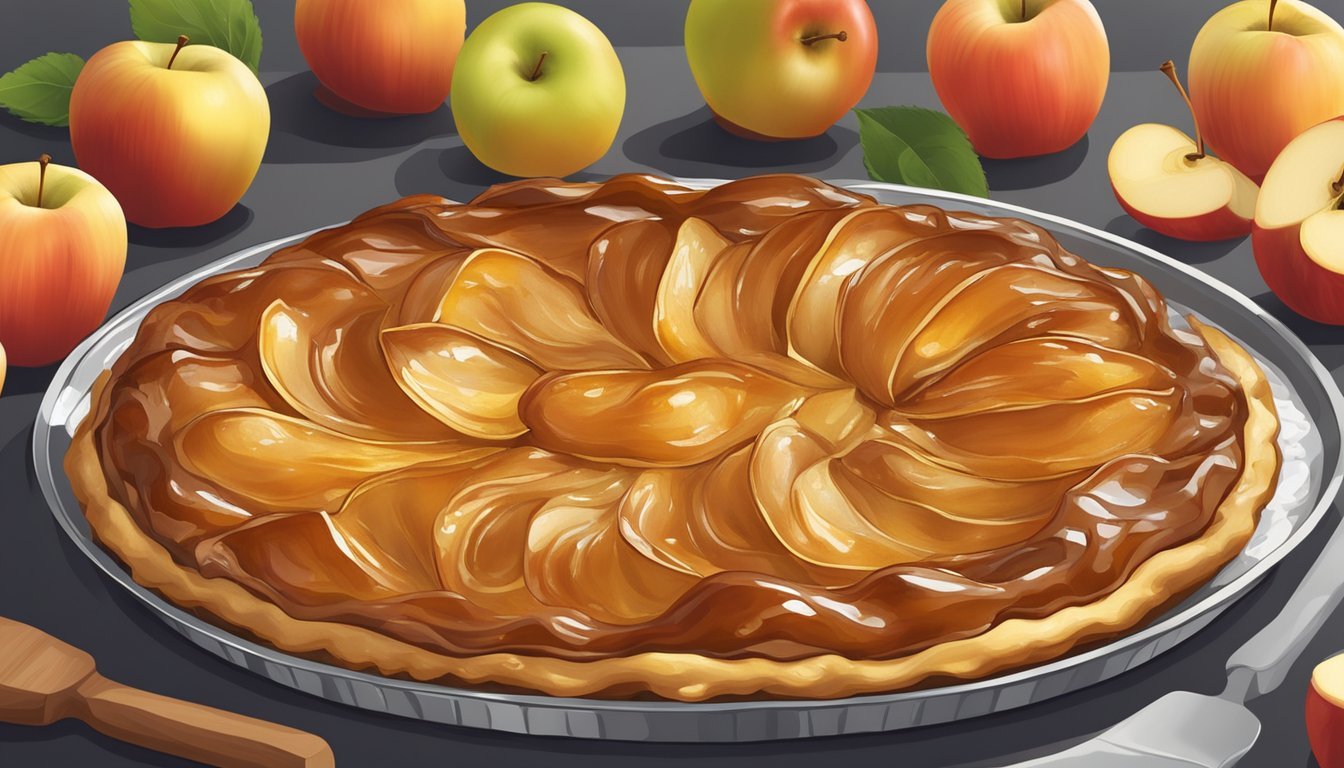Best Way to Reheat Tarte Tatin
Ensuring Crispy Pastry and Perfect Caramelized Apples
A Tarte Tatin combines the tender sweetness of caramelized apples with a buttery, flaky pastry, and reheating this classic French dessert (What wine goes well with desserts?) is an art in itself. Maintaining the delicate balance between the crisp pastry and the soft, caramelized fruit is key to experiencing the dessert as intended. Whether made ahead of time or saved as leftovers, there are effective methods to reheat Tarte Tatin that ensure it retains its distinctive textures and flavors.
The choice of oven temperature, the position of the tart in the oven, and the duration of reheating are crucial factors. It is generally recommended to reheat Tarte Tatin in a moderately heated oven. This gentle warming allows the pastry to return to its crispy state without causing the caramel to become too runny or the apples to turn mushy.
Care must be taken not to overheat the Tarte Tatin, as this can result in a soggy pastry and overly liquefied caramel. The goal is to revive the dish to its freshly baked glory, where every bite offers the harmonious contrast between a caramelized apple topping and a crisp, golden base. With attention to these details, the Tarte Tatin can be brought back to life, making it just as enjoyable as when it was first baked.
Understanding Tarte Tatin
The delight of a well-prepared Tarte Tatin lies in its contrasting textures and rich flavors. This French dessert is a balance of caramelized apples and crisp pastry.
Components of Tarte Tatin
Tarte Tatin typically comprises two main components: a top layer of caramelized apples and a bottom layer of buttery pastry. The dessert is inverted before serving, showcasing the shiny, caramel-coated apples that sat at the bottom during the baking process. The ingredients are simple yet decadent:
Apples: Usually firm varieties that can withstand cooking without losing shape.
Pastry: A shortcrust or puff pastry that offers a crisp texture once baked.
Caramel: Created by cooking sugar and butter together until golden and syrupy.
History of the French Dessert
Tarte Tatin owes its origins to the Tatin sisters, who ran the Hotel Tatin in Lamotte-Beuvron, France, in the 1880s. The dessert was purportedly created by accident when one of the sisters, attempting to make a traditional apple pie, left the apples cooking in butter and sugar for too long. In a hurry to rescue the dessert, she covered the apples with pastry and placed the skillet in the oven. After baking, the dessert was flipped to reveal a beautifully caramelized upside-down tart. This happy accident gave birth to what is now known as Tarte Tatin, a beloved French dessert that has stood the test of time.
Preparation Basics
In the journey of reheating Tarte Tatin, the initial preparation plays a crucial role in ensuring that the apples maintain that deep caramelization and the pastry remains crisp. The selection of ingredients and the handling of these components are fundamental to achieving the desired results.
Selecting the Right Apples
Choosing the correct type of apples is pivotal to the success of an Apple Tarte Tatin. Firm apples that hold their shape during cooking are essential. Varieties such as Granny Smith or Honeycrisp are often favored for their balance of tartness and sweetness, as well as their ability to withstand high temperatures without turning mushy. One should ensure that the apples are peeled and cored consistently to promote even cooking.
Creating the Perfect Pastry
The pastry serves as the foundation of a Tarte Tatin and it must be capable of providing a crisp, flaky contrast to the soft, caramelized apples. Puff pastry is the most common choice. It should be rolled out evenly to a thickness that neither underwhelms nor overpowers the apples. When making the pastry, it's important to handle it as little as possible to avoid activating the gluten, which can make the dough tough. The pastry should be cooked until it is golden brown, which typically requires an oven temperature of 350°F to 375°F (175-190°C). For reheating, the Tarte Tatin should be allowed to come to room temperature first to ensure an even warmth throughout without overcooking.
Baking and Flipping Techniques
In reheating Tarte Tatin, one must focus on maintaining the pastry's crispiness and enhancing the caramelization of the apples. Careful execution of baking and flipping techniques is essential.
Achieving Golden Brown Perfection
The oven should be preheated to an ideal temperature of 350°F (175°C) for reheating. If a skillet was used originally to cook the tart, it can be placed directly in the oven. The goal is to warm the tart thoroughly and achieve a golden brown hue in the pastry without burning the sugar. Monitoring the tart carefully during baking is crucial for preserving its delicate balance of textures and flavors.
Temperature: Exactness in setting your oven to 350°F (175°C) is key.
Time: Baking time will vary, but one should start checking the tart after about 10 minutes.
Technique: Using a skillet may help in evenly reheating and spontaneous caramelization.
Safe and Effective Tart Flipping Tips
Once the Tarte Tatin is warmed appropriately with a crispy pastry and delectably caramelized apples, the flip is next in line. The tart should be loosened gently using a knife along the edges to prevent sticking. When flipping, one needs to be swift but careful to keep the integrity of the tart's structure.
Loosening: Running a knife around the edge of the tart breaks the seal and allows for an easier flip.
Flipping: Place a serving plate over the skillet. With oven mitts, hold the skillet and plate tightly together and flip in one smooth motion.
Safety: Ensure that both hands are protected with oven mitts and the flipping is done swiftly to avoid any mishaps.
Reheating Methods
Proper reheating is crucial to maintain the crispy pastry crust and caramelized apples of a tarte tatin. These methods emphasize controlled heat to revive the tart's desirable texture and taste.
Oven Reheating Process
To reheat tarte tatin in an oven, one should:
Preheat the oven to 350°F (175°C).
Place the tarte tatin on an oven-safe dish, and if it's been refrigerated, let it come to room temperature first.
Loosely cover the tarte tatin with aluminum foil to prevent the crust from burning.
Heat for about 15-20 minutes, checking periodically. For a tarte tatin that has been frozen, increase the time to 20-25 minutes.
Alternative Reheating Tips
While the oven is ideal, one can also use a skillet for reheating:
Skillet Method: Heat the skillet over medium heat and place the tarte tatin in it. Cover with a lid and heat for a few minutes until warm and the bottom crust is crisp.
Remember, each kitchen appliance may behave differently, so keep an eye on the tarte tatin as it reheats and adjust the heat as necessary.
Ensuring Crispiness
To achieve the perfect reheated tarte tatin, balancing moisture and heat to maintain the pastry’s crispiness is crucial. The pastry should emerge from the oven with a flaky crust, echoing the freshness of its initial bake.
Maintaining Moisture Balance
The tarte tatin's pastry retains its crispiness when reheated with a careful balance of moisture. Preheat the oven to 350°F (175°C) to promote even reheating. Place the tarte tatin on a baking sheet to ensure heat distribution and to catch any drips, preventing oven moisture buildup. Wrapping the pastry in aluminum foil can shield it from direct heat, reducing the risk of it drying out.
Tips for Moisture Balance:
Preheat the oven thoroughly before baking.
Utilize a baking sheet for even heat distribution.
Cover with foil to protect from excessive dryness.
Preventing a Soggy Pastry Bottom
A soggy pastry bottom diminishes the appeal of a tarte tatin. To prevent this, one must ensure that the tarte tatin is heated through without steaming the pastry. After preheating the oven, place the tarte tatin directly on a warmed baking sheet. This initiates a quick, crisp bake from the bottom up, safeguarding the flaky crust.
Strategies to Avoid Soggy Pastry:
Warm the baking sheet in the preheated oven beforehand.
Minimize the baking time to prevent moisture penetration.
Serving Suggestions
A reheated Tarte Tatin isn't complete without considering how it is served. The choice of accompaniments and the method of plating can greatly enhance the dessert's appeal.
Accompaniments and Toppings
When presenting a Tarte Tatin, it’s essential to balance the inherent sweetness of the caramelized apples with complementary toppings. A scoop of vanilla ice cream is a classic choice, providing a cool contrast to the warm tart while its creamy texture complements the crisp pastry. Alternatively, a dollop of whipped cream can add a light and airy accompaniment that melds harmoniously with the rich flavors.
Ice Cream: A scoop of vanilla ice cream not only adds a creamy texture but also a subtle vanilla essence that pairs well with the caramelized apples.
Whipped Cream: Whipped cream brings a smooth and light finish to each bite, cutting through the sweetness.
Plating Techniques
The presentation of Tarte Tatin should be as elegant as the dessert itself. One should transfer the tart onto a serving plate with care to maintain its shape. Inverting the tart so the apples are on top showcases their glossy, caramelized appearance. Serve each slice with a topping of choice, being mindful of proportions to ensure every forkful contains the perfect balance of flavors.
Serving Plate: Choose a plate that complements the rustic charm of the tart. A clean, white plate can make the colors pop, while a more ornate plate can enhance the dessert's elegance.
Portion Size: Whether providing a single large scoop of ice cream or a dollop of whipped cream, it should be proportionate to the slice of tart, ensuring that the pastry and apples remain the stars of the show.
Storage and Preservation
Proper storage is essential to maintaining the fresh taste and texture of Tarte Tatin. Understanding how to store this dessert can ensure its pastry stays crispy and its caramelized apples remain luscious when it's time to serve again.
Best Practices for Storing Tarte Tatin
To keep Tarte Tatin in its best condition, it should be refrigerated within two hours of baking to prevent spoilage. Wrapping the tart tightly in plastic wrap or aluminum foil can deter moisture loss. Alternatively, placing it in an airtight container also safeguards against drying out. It is crucial to allow the tart to cool to room temperature before refrigerating to prevent condensation that can lead to soggy pastry.
Cooling: Let the Tarte Tatin cool at room temperature.
Wrapping: Wrap it tightly with plastic wrap or aluminum foil.
Container: Place in an airtight container to preserve freshness.
Location: Refrigerate, keeping away from strong-odored foods.
Longevity and Quality Maintenance Tips
The longevity of a Tarte Tatin's quality can be maximized through careful preservation. Butter and sugar, the primary components of its caramel, act as preservatives themselves. However, for the homemade Tarte Tatin to retain its special appeal, it should be consumed within three to four days. The tart's pastry, which contains butter, does not fare well in the freezer as it can become soft and lose its textural contrast. If freezing is necessary, one might consider freezing the components separately before assembly.
Consumption: Best consumed within three to four days.
Freezing: Not recommended; can negatively affect texture.
Troubleshooting Common Issues
In reheating Tarte Tatin, one may encounter issues with caramelization and pastry texture. Below are targeted approaches to resolve these specific challenges and ensure the dish retains its quality and flavor.
Resolving Under-Caramelization
Under-caramelization can result in a lackluster flavor profile. The sugar should reach a deep amber color before adding the apples. If the caramel is too light in color, one can carefully return the Tarte Tatin to a low flame, allowing the sugar to darken to the desired shade. To avoid burning the caramel, monitor the color closely and swirl the pan for even heat distribution.
Expert Tip: Before reheating in the oven, revisit the caramel on the stovetop if needed. A few minutes on low heat may save the dessert from being underwhelming.
Addressing Pastry Challenges
The appeal of Tarte Tatin's pastry hinges on retaining its crispiness. If the pastry becomes soggy or dense, the dessert loses its textural contrast. Here's how to prevent such issues:
Ensure the pastry is properly thawed before baking if using puff pastry.
Place the Tarte Tatin in a preheated oven at 350°F (175°C) when reheating.
Heat on a lower-middle rack on top of a rimmed baking sheet to catch drips.
For a crisper base, one can briefly expose the pastry directly to the bottom heat element towards the end of the reheating process.
Note: Keep a watchful eye during this step to prevent burning.
By being mindful of these factors and employing attentive techniques, one can deftly surmount common difficulties encountered when reheating Tarte Tatin.
Advanced Tips for Enthusiasts
For those who have mastered the basics of tarte tatin, pushing the envelope with precise techniques and flavor profiles can elevate this classic dessert. These advanced tips are for enthusiasts looking to refine their tarte tatin, ensuring the pastry stays crisp and the apples perfectly caramelized.
Recipe Variations and Experiments
Experimentation with apple varieties can significantly influence the final texture and taste of your tarte tatin. Firm apples like Honeycrisp or Granny Smith maintain their structure and offer a balance of sweetness and tartness. To push boundaries, one can consider using a mix of apple types to create a complex flavor profile.
Playing with recipe variations such as substituting the traditional sugar with maple syrup or honey for caramelization, or adding spices like cinnamon or cardamom can introduce new dimensions to the flavor. It is important to adjust cooking times accordingly, as different sweeteners and apple varieties may change the rate at which the tarte caramelizes.
Mastering the Art of Tarte Tatin
True mastery lies in the subtle nuances that transform good into great. Professionals know that baking time is critical: a tarte tatin should be baked until the pastry is a golden brown and the caramelization of the fruit is just right. To perfect this, a watchful eye and experience are more reliable than strict timings, as oven temperatures can vary.
Expert tips often include advising cooks to warm the pan before adding the butter and sugar to ensure a more uniform caramel. And when reheating, a moderate oven temperature of 350°F (175°C) helps revive the pastry's crispness without overcooking the apples.
Employing these strategies with confidence and knowledge will yield a tarte tatin that boasts a professionally crisp pastry with succulent, well-caramelized apples—an experience any tarte tatin enthusiast aspires to perfect.
Tarte Tatin FAQs
This section addresses common concerns around reheating Tarte Tatin, focusing on preserving the quality of both the pastry and the apples.
Common Queries Resolved
How does one reheat Tarte Tatin to maintain a crispy pastry? Preheat the oven to 350°F (175°C). Place the Tarte Tatin in the oven for a few minutes until it is warm and the pastry has returned to a crispy texture.
What's the best way to keep the apples caramelized when reheating? Reheat the Tarte Tatin as detailed above, ensuring not to overheat as this could cause the apples to become mushy rather than staying nicely caramelized.
Can Tarte Tatin be made ahead of time? Yes, Tarte Tatin can be prepared in advance and reheated. It's recommended to let the tart cool in the pan to help the caramel set, then reheat gently before serving.
Are there any preferred ingredients to use when making a Tarte Tatin that will reheat well? Classic French recipes recommend using butter rather than shortening for the crust and suggest that while puff pastry can be used, some find a short crust to better maintain its texture when reheated.
What is the best way to serve reheated Tarte Tatin? Once reheated, Tarte Tatin should be served warm. It pairs beautifully with a scoop of vanilla ice cream or a dollop of crème fraîche.
Are there any particular recipes that offer the best results for reheating? Recipes vary, but it's generally agreed that a Tarte Tatin that uses a sturdy pastry and properly caramelized fruit will reheat well, retaining its texture and flavour.












